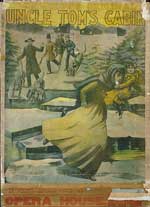VAM galleries including this work:
The Kentucky Historical Society | What’s the Point? || VAM Home
Unknown artist
THEATER POSTER, UNCLE TOM’S CABIN, c. 1880
Print on paper
Donated by Wade Hall, 1998.86.62
Courtesy Kentucky Historical Society
Of all the performance texts of the anti-slavery cause, the best remembered are dramatizations of Harriet Beecher Stowe’s 1852 novel Uncle Tom’s Cabin. Stowe herself denounced these adaptations as simplistic, and performances were seldom used as abolitionist fund-raisers, so they are not considered documents of the movement. But they were America’s most-performed melodramas in the 19th century, a staple of traveling theater companies throughout the century. This poster may have been used to promote the theatrical production of Jay Rial’s Uncle Tom’s Cabin at the Louisville Opera House.
Uncle Tom’s Cabin has additional Kentucky connections. In A Key to Uncle Tom’s Cabin, Stowe explained that many of her characters were composites of people she had heard about or met. Josiah Henson, who once lived on the Amos Riley plantation in Daviess County, was one of the inspirations for the character Uncle Tom. Lewis Clark, an escaped slave from Garrard County, may have inspired the character George Harris.
Classroom Ideas
Discussion: What is the purpose of a theatrical poster? How did the artist who created this poster use the elements of art and principles of design to achieve that purpose? How does this poster compare to contemporary theater and film posters?
Harriet Beecher Stowe felt that popular stage adaptations did not capture the complexities of her novel. What different qualities do novels, plays, and movies have that make storytelling different in each medium? Watch a stage or film version of a book you have read as a class and then discuss the differences between the versions.
Activity: Create theater posters for a variety of books. Write a scene for a stage version of a book you have read.
Note: This image also relates to social studies content: the study of U.S. history and the political, social, economic, and cultural differences among sections of the U.S. that resulted in the American Civil War.
Links
Uncle Tom’s Cabin and American Culture, from the University of Virginia, includes extensive information about the Stowe work and its stage presentations.
[www.iath.virginia.edu/utc/sitemap.html]
A Novel Idea, part of the University of Virginia Library’s exhibition In the Brilliancy of the Footlights: Creating America’s Theatre, includes additional information and images relating to theatrical presentations of Uncle Tom’s Cabin.
[www.lib.virginia.edu/small/exhibits/theatre/idea_cabin.html]
North American Slave Narratives, on the Documenting the American South web site, includes firsthand accounts of the lives of slaves in America.
[docsouth.unc.edu/neh]
The following articles in the Kentucky Encyclopedia have more information on topics relating to this image (subscription required for online version):
- Henson, Josiah
[www.kyenc.org/entry/h/HENSO01.html] - Slavery
[www.kyenc.org/entry/s/SLAVE02.html] - Theater
[www.kyenc.org/entry/t/THEAT01.html] - Uncle Tom’s Cabin
[www.kyenc.org/perl/entry_result.perl?ID=UNCLE01&words=Uncle%20Tom's%20Cabin&SearchType=Full]
